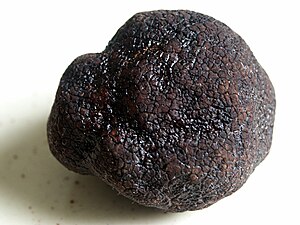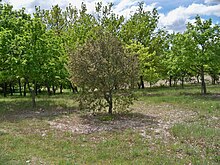Perigord truffles
| Perigord truffles | ||||||||||||
|---|---|---|---|---|---|---|---|---|---|---|---|---|

Perigord truffle ( Tuber melanosporum ) |
||||||||||||
| Systematics | ||||||||||||
|
||||||||||||
| Scientific name | ||||||||||||
| Tuber melanosporum | ||||||||||||
| Vittad. |
The Perigord truffle ( Tuber melanosporum ), also called black truffle , is a real truffle from southern Europe that is one of the most expensive edible mushrooms in the world.
Taxonomy
It was first described in 1831 by the Italian mycologist Carlo Vittadini . The synonymous species names are Tuber brumale , Tuber gulosorum , Tuber nigrum , Tuber cibarium and Tuber gulonum .
features
The tuberous, dark-brown fruiting bodies ( ascocarps ) have a black-brown surface, which consists of pyramidal cusps. They smell strongly aromatic and usually reach a size of up to 10 cm. However, a few specimens are much larger and, like a find from 2012 in the Dordogne department, can weigh over a kilogram. The initially white, later dark fruit mass is traversed by white veins that turn brownish with age. The spores are elliptical and 22–55 µm by 20–35 µm in size. They are dark brown in color and have large spines.
Species delimitation
The black truffle is morphologically very similar to the less valued Chinese truffle ( Tuber indicum ). In order to prevent mix-ups or fraud in trading, an RFLP analysis was developed with which the two types of fungus can be clearly distinguished genetically. According to the Food Book Commission, Chinese truffles can be declared as black truffles. External distinguishing features are the dark red to dark brown, smoother skin of the Chinese truffle. The summer ( T. aestivum ) and winter truffles ( T. brumale ), which are found a little further north, have a lighter flesh.
ecology
Way of life and phenology
Black truffles grow at a depth of 5–50 cm as ectomycorrhizal fungi on their herbal symbiosis partners. These are holm oak , common oak , hazel, cherry and other deciduous trees. They prefer loose limestone soils. Particularly for the symbiosis between Tuber melanosporum and holm oak seedlings, it could be shown that the fungus in the plant causes increased photosynthesis performance and increased root growth. The increased photosynthesis does not lead to a larger growth of the plants, but to an increased formation of cell wall material.
The almost vegetation-free periphery ( French brûlé) of the host plants is due to the fact that T. melanosporum parasitizes other plants at the roots, so that the plants die off due to necrosis in the root bark . In addition, some of the fragrances can impair the development of plants by triggering oxidative stress.
The fruiting bodies form between April and June, but harvesting takes place between November and March.
Reproduction
Wild boars and the larvae of the truffle fly, which feed on the fruiting bodies, excrete the spores undigested with their feces and thus contribute to the spread of the truffle. The excreted manure also acts as fertilizer for the germinating spores. They are found in common with the winter truffle ( Tuber brumale ), which favors the growth of T. melanosporum when the soil has a high water content.
Only a study published in 2010 refuted the previous assumption that all types of truffle are self-compatible ( homothallic ). It could be shown that the black truffle is self-incompatible ( heterothallic ), that is, sexual reproduction with the accompanying fruiting body formation is based on the crossing between mycelia , which correspond to a different mating type . In the development of mycelia of different mating types on a tree, one of the two mating types dominates over time. This observation is of practical importance for the establishment of truffle plantations: In order to achieve larger truffle harvests, it must be ensured that mycelia of different mating types develop on neighboring trees. For this purpose, the seedlings of the host trees can be inoculated in advance with the pre-cultivated mycelium of a mating type.
distribution
The natural range of the black truffle stretches over different regions in Spain, France and Italy, which probably served as refuges for the host plants during the last ice age. The truffles are now also cultivated in Australia, New Zealand and North America.
meaning
Genome
The black truffle genome, published in 2010, contains 125 million base pairs. 58% of the genome correspond to transposable elements . Only 7500 protein- coding genes were identified. During the symbiosis, genes are induced that are involved in the breakdown of plant cell walls and lipids. Therefore, the black truffle seems to break down the cell walls of the host plant at the beginning of the symbiosis .
Aroma and fragrances
The scent of the fruit bodies of the black truffle is reminiscent of undergrowth, strawberries, damp earth or dried fruits with a cocoa note. The taste, which only fully develops after heating, is slightly peppery and bitter. Storage at room temperature leads to oxidation and volatilization of the flavoring substances, whereas storage at 0 ° C leads to an increased synthesis of flavoring substances. The fruit bodies produce various fragrances such as the alcohols 2- and 3-methylbutanol, the aldehydes 2- and 3-methylbutanal and traces of sulfur compounds. The latter includes dimethyl sulfide , which acts as an attractant on truffle dogs and pigs. The same substance also attracts truffle flies, which lay their eggs directly on the ground above the fruiting bodies. The hatching larvae look for the truffles and use them as their first source of food. Different yeast species were isolated from Tuber melanosporum and T. magnatum , which form part of the aromatic substances.
Trade and use

The search for black truffles and their cultivation have a tradition that goes back over 200 years in southern Europe, especially in French areas such as Périgord or Dordogne . Meanwhile, breeders in California, Australia and New Zealand are also setting up truffle plantations with appropriate host plants. For example, roots of hazelnuts are infected with truffle spores so that the first fruiting bodies can be harvested after four to ten years. With a kilo price between 1000 euros and 2000 euros, the black truffle is the second most expensive truffle after the Alba truffle and one of the most popular edible mushrooms. In contrast to the Alba truffle, the black truffle does not lose its aroma when cooked; the taste becomes even more intense. The black truffle is used to refine meat , fish , soups and risotto .
Web links
Individual evidence
- ↑ first-nature.com, accessed on January 3, 2016
- ^ Ewald Gerhardt: The great FSVO mushroom guide for on the go . 5th edition. BLV, Munich 2011, ISBN 978-3-8354-0644-5 , p. 662 .
- ↑ a b c Hans E. Laux: The great cosmos mushroom guide. All edible mushrooms with their poisonous doppelgangers . Kosmos, Stuttgart 2010, ISBN 978-3-440-12408-6 , pp. 688 .
- ↑ news.orf.at (accessed on June 16, 2013)
- ↑ Bruno Cetto: Täublinge, Milchlinge, Boviste, Morels, Becherlinge etc. In: Enzyklopädie der Pilze . tape 4 . BLV, Munich 1988, ISBN 3-405-13477-3 , p. 477 .
- ↑ Francesco Paolocci, Andrea Rubini, Bruno Granetti, Sergio Arcioni: Typing Tuber melanosporum and Chinese black truffle species by molecular markers . In: FEMS Microbiology Letters . tape 153 , no. 2 , 1997, p. 255–260 , doi : 10.1111 / j.1574-6968.1997.tb12582.x .
- ↑ Lebensmittelklarheit.de: Names for truffles , February 26, 2018
- ↑ Angelo Pellegrini: Little Truffle Lore ( Memento of the original from January 2, 2014 in the Internet Archive ) Info: The archive link was inserted automatically and has not yet been checked. Please check the original and archive link according to the instructions and then remove this notice. . On: www.trueffel-seminar.de
- ↑ The code of the truffle gene has been deciphered . welt.de, accessed on June 16, 2013.
- ↑ a b C. C. Linde, H. Selmes: Genetic Diversity and Mating Type Distribution of Tuber melanosporum and Their Significance to Truffle Cultivation in Artificially Planted Truffiéres in Australia . In: Applied and Environmental Microbiology . tape 78 , no. 18 , September 15, 2012, p. 6534-6539 , doi : 10.1128 / AEM.01558-12 , PMID 22773652 .
- ↑ Andrea Nardinia, Sebastiano Salleo, Melvin T. Tyree, Moreno Vertovec: Influence of the ectomycorrhizas FORMED by Tuber melanosporum Vitt. on hydraulic conductance and water relations of Quercus ilex L. seedlings . In: Annals of Forest Science . tape 57 , no. 4 , May 2000, pp. 305-312 , doi : 10.1051 / forest: 2000121 .
- ^ I. Plattner, IR Hall: Parasitism of non-host plants by the mycorrhizal fungus Tuber melanosporum . In: Mycological Research . tape 99 , no. 11 November 1995, pp. 1367-1370 , doi : 10.1016 / S0953-7562 (09) 81223-9 .
- ↑ Richard Splivallo, Mara Novero, Cinzia M Bertea, Simone Bossi, Paola Bonfante: Truffle volatiles inhibit growth and induce an oxidative burst in Arabidopsis thaliana . In: The New phytologist . tape 175 , no. 3 , 2007, p. 417-424 , doi : 10.1111 / j.1469-8137.2007.02141.x , PMID 17635217 .
- ↑ a b c Black truffle. In: Kitchen Lexicon. huettenhilfe.de, accessed on June 16, 2013.
- ↑ M. Mamoun, JM Olivier: Competition between Tuber melanosporum and other ectomycorrhizal fungi under two irrigation regimes . In: Plant and Soil . tape 149 , no. 2 , February 1, 1993, p. 211-218 , doi : 10.1007 / BF00016611 .
- ↑ Andrea Rubini, Beatrice Belfiori, Claudia Riccioni, Sergio Arcioni, Francis Martin, Francesco Paolocci: Tuber melanosporum: mating type distribution in a natural plantation and dynamics of strains of different mating types on the roots of nursery-inoculated host plants . In: New Phytologist . tape 189 , no. 3 , 2011, p. 723-735 , doi : 10.1111 / j.1469-8137.2010.03493.x .
- ^ Francis Martin et al.: Périgord black truffle genome uncovers evolutionary origins and mechanisms of symbiosis . In: Nature . tape 464 , no. 7291 , April 15, 2010, p. 1033-1038 , doi : 10.1038 / nature08867 .
- ↑ a b Franco Bellesia, Adriano Pinetti, Alberto Bianchi, Bruno Tirillini: The volatile organic compounds of black truffle (. Tuber melanosporum Vitt) from Middle Italy . In: Flavor and Fragrance Journal . tape 13 , no. 1 , 1998, p. 56-58 , doi : 10.1002 / (SICI) 1099-1026 (199801/02) 13: 1 <56 :: AID-FFJ692> 3.0.CO; 2-X .
- ↑ Laura Culleré, Vicente Ferreira, Berenger Chevret, María E. Venturini, Ana C. Sánchez-Gimeno, Domingo Blanco: Characterization of aroma active compounds in black truffles (Tuber melanosporum) and summer truffles (Tuber aestivum) by gas chromatography – olfactometry . In: Food Chemistry . tape 122 , no. 1 , September 1, 2010, p. 300–306 , doi : 10.1016 / j.foodchem.2010.02.024 .
- ↑ T. Talou, A. Gaset, M. Delmas, M. Kulifaj, C. Montant: Dimethyl sulphide: the secret for black truffle hunting by animals? In: Mycological Research . tape 94 , no. 2 , March 1990, p. 277-278 , doi : 10.1016 / S0953-7562 (09) 80630-8 .
- ↑ Jürg Bischoff: The truffle plantation . www.nzz.ch, December 31, 2006, accessed June 16, 2013.
- ↑ Pietro Buzzini et al: Production of volatile organic compounds (VOCs) by yeasts isolated from the ascocarps of black (Tuber melanosporum Vitt.) And white (Tuber magnatum Pico) truffles . In: Archives of Microbiology . tape 184 , no. 3 , November 1, 2005, pp. 187-193 , doi : 10.1007 / s00203-005-0043-y .
- ↑ Tobias Jochim: Truffle . gourmetglobe.de, accessed on June 16, 2013.
